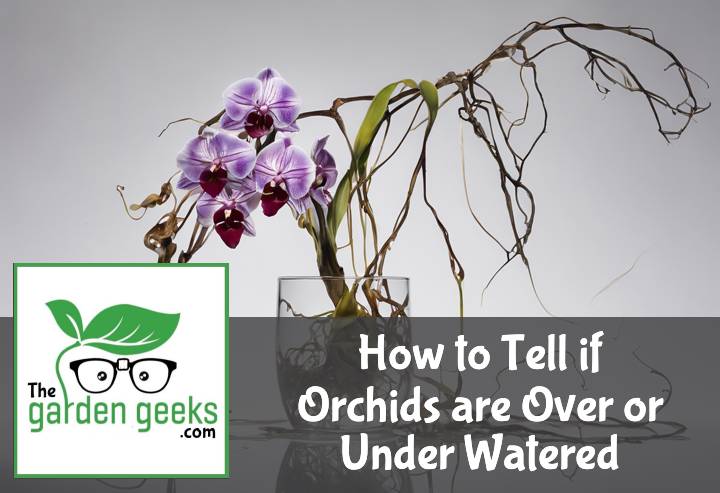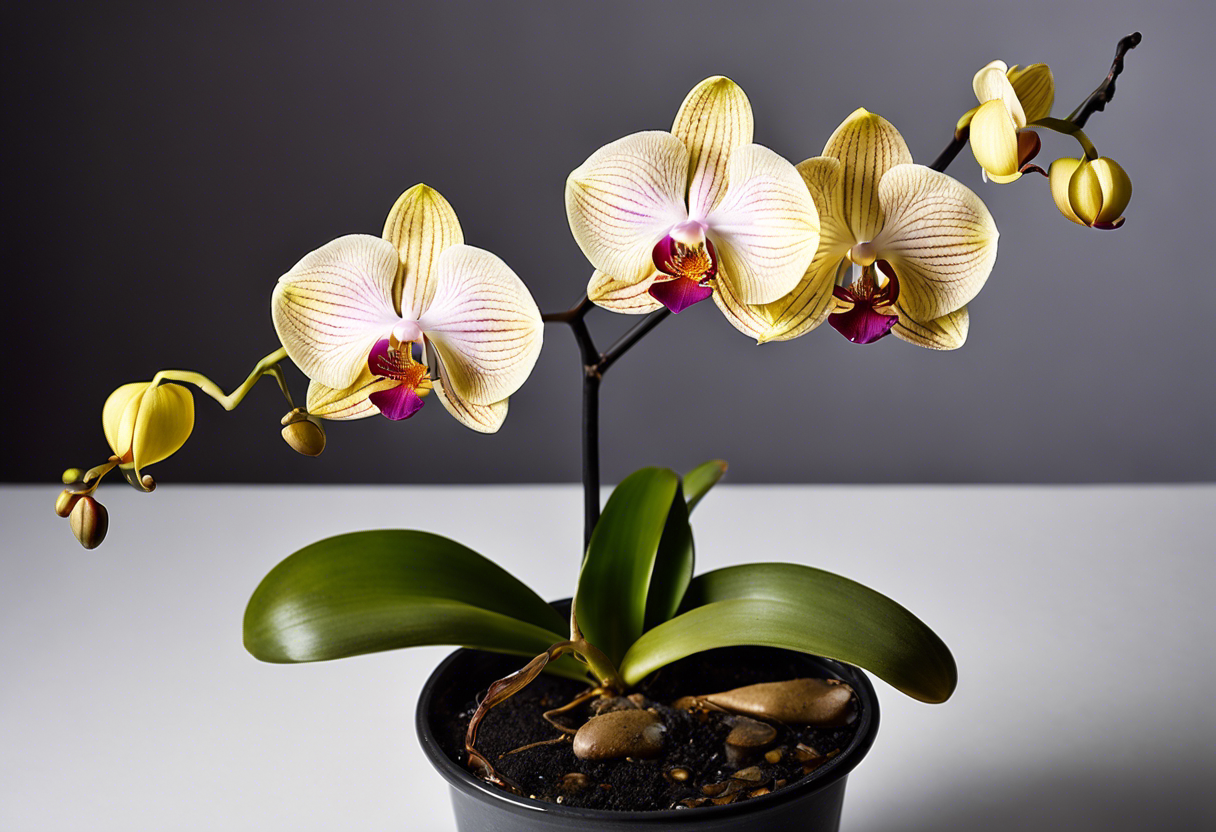Ever looked at your orchids and wondered, “Are they getting too much or too little water?” Yeah, me too! It’s a common concern for all us orchid lovers out there. How to Tell if Orchids are Over or Under Watered can be a bit of a puzzle. But don’t worry, I’m here to help you crack the code!
In this blog post, we’ll delve into the telltale signs of overwatering and underwatering. So buckle up, grab your watering can, and let’s get down to business. Keep reading about ‘How to Tell if Orchids are Over or Under Watered (With Photos)’.
Key Takeaways
- Overwatered orchids often have yellow leaves and black, mushy roots.
- Underwatered orchids display wrinkled leaves and white, dry roots.
- Photos can help identify these signs: compare your plant to images of healthy, overwatered, and underwatered orchids.
- Correct watering involves soaking the roots then allowing them to dry out fully before re-watering.
- Orchids’ water needs vary based on factors like species, potting medium, and environment.
Understanding Orchid Watering Needs
When it comes to orchid care, getting the watering right is a big deal. It’s not just about giving your orchids a drink when you remember. No siree! It’s about understanding the specific orchid watering needs and maintaining them for optimal orchid health.
The Importance of Proper Watering for Orchids
Now, why is proper watering so important? Well, imagine trying to survive on soda instead of water. Not great, right? Same goes for orchids. They need the right amount of water to thrive and grow.
Overwatering or underwatering can lead to all sorts of problems. Overwatered orchids might start looking like they’ve had too much fun at a pool party—leaves turning yellow and roots rotting away. On the other hand, underwatered orchids can end up looking like they’ve been left in the desert—wrinkled leaves and dry roots.
So, if you want your orchids to have that “just-right” Goldilocks vibe, you gotta nail the watering part. This way, you’ll ensure optimal orchid growth and keep those beautiful blooms coming!
Factors Influencing Orchid Watering Requirements
But hold up! Before you rush off with your watering can, there are a few things to consider. Different factors can influence how much water an orchid needs.
Firstly, different orchid types have different watering requirements. Some are like camels—they don’t need much water at all! Others are more like fish—they love being surrounded by moisture!
Then there’s the environment to think about. Things like humidity levels and temperature can affect how thirsty your orchids get. For instance, in high humidity conditions (humidity and orchids, remember?), your plants might not need as much water.
On the flip side, if it’s hotter than a jalapeño in your orchid’s spot (temperature effects on watering), you might need to water more frequently. So, understanding these specific orchid watering requirements is key to keeping your plants happy and healthy.
Remember, knowing how to tell if orchids are over or under watered is a crucial part of orchid care. So, keep an eye out for those signs and adjust your watering routine as needed!
Identifying Overwatered Orchids
Recognizing overwatered orchids is vital for maintaining their health and longevity. It’s all about being observant, folks! Look out for telltale signs and nip the issue in the bud.
Physical Signs of Overwatering in Orchids
Overwatering can cause a few physical changes in your beloved orchid. One of the first signs you’ll notice is a change in orchid leaf color. Healthy leaves are usually a vibrant green, but overwatered ones? They turn yellow or brownish, looking more like autumn leaves than anything else.
Another sign is root condition. If your orchid’s roots look more like mushy spaghetti than sturdy anchors, it’s a clear case of overwatering causing root rot in orchids. And let’s not forget about the flowers. Wilted orchid flowers are another red flag that your plant might be getting too much H2O.
Long-Term Effects of Overwatering on Orchids
Consistent overwatering isn’t just bad news for today; it can have lasting effects on your orchid’s overall health and lifespan. Over time, it can lead to various orchid diseases, making your plant more susceptible to infections and pests.
And if you’re dreaming of an orchid that grows tall and strong, well… overwatering can stunt its growth. That’s right – stunted growth in orchids is a real thing! Lastly, remember that the lifespan of overwatered orchids tends to be shorter than those receiving proper care. So keep an eye on that watering can!
Remember folks, knowing How to Tell if Orchids are Over or Under Watered is key to keeping them healthy and blooming beautifully!
Identifying Underwatered Orchids
When it comes to orchid care, one common issue is underwatering. It’s a tricky balance, but knowing the signs can help you figure out how to tell if orchids are over or under watered.
Physical Signs of Underwatering in Orchids
First off, let’s chat about the physical symptoms. An underwatered orchid often shows signs of dehydration. You might notice the leaves looking a bit sad and droopy. They’re basically screaming, “Hey! We need water here!”
Another sign is dry orchid roots. If they’re more reminiscent of a desert than a lush rainforest, your orchid could be parched. And don’t even get me started on wilting orchids – those guys are practically begging for a drink!
Long-Term Effects of Underwatering on Orchids
Now onto the long-term effects. Continuous underwatering can lead to some serious damage to your beloved orchids.
One major consequence? Stunted growth. Your orchid might start acting like that sulky teenager who refuses to grow up!
And then there’s the damage to the plant itself. Over time, chronic dehydration can cause irreversible harm to your orchid’s health and vitality. So remember folks, keep an eye out for these signs and give your green friends the hydration they crave!
How to Correctly Water Your Orchids
Proper watering is the lifeblood of orchid health. It’s not just about dumping water on your plant; it’s a science and an art. And, like any good artist, you need to know your craft.
Correct Watering Techniques for Healthy Orchids
So, what are the secrets of orchid watering techniques? Well, first off, don’t drown ’em! Orchids aren’t big fans of soggy feet. They prefer a “less is more” approach when it comes to hydration.
Next up: timing. The best time to water orchids? Early morning. This gives them plenty of time to dry out before nightfall and helps prevent diseases.
And frequency? That’s where things get tricky. The watering frequency depends on many factors like humidity, temperature, and the type of orchid you have.
Adjusting Your Watering Routine Based on Observations
Now that you’ve got the basics down pat, let’s talk about adjusting watering routine based on what your orchid tells you.
Yes, you heard right! Your orchid can talk… well sorta. It communicates through its leaves and roots. If they’re yellow or wilted, it might be screaming “I’m overwatered!” On the other hand, if they’re shriveled or crispy, it might be whispering “I need more water.”
By observing orchid condition, you can learn how to tell if orchids are over or under watered and adjust accordingly. Remember folks – in the world of orchid care, vigilance is key!
To Wrap Up
Well, there you have it folks! We’ve navigated the jungle of How to Tell if Orchids are Over or Under Watered like a seasoned explorer. Remember, your orchid is like a finicky house guest—too much water and they’re sloshing around in galoshes; too little and they’re parched.
Keep an eye out for those tell-tale signs we discussed and soon enough, you’ll be the Sherlock Holmes of orchid care. Now go forth, and may your watering can always hold just the right amount!





